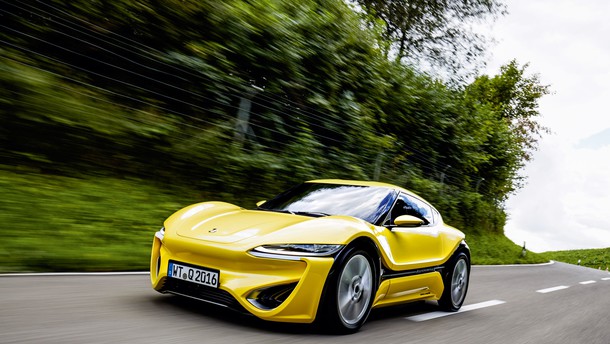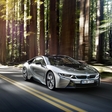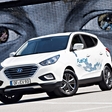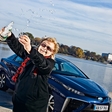
Nunzio La Vecchia is a kind man with a youthful face, crested by heavily gel-styled hair. "You'll be the first to drive this car all by yourself. Before, I always tagged along." says the self-professed e-mobility pioneer, who's been up against a strong headwind over the last year. His NanoFlowCell was subject to much criticism, with adjectives such as "impractical" and "immature" being among the kindest. After all, it was often received as being far too daring. His vehicle is not powered by a battery made of cells, but from positively and negatively-charged electrolyte fluids, which generate electricity with the help of a membrane. Electricity is then stored by two supercapacitors, which supply power to electric motors. Flow cell technology was developed in the previous century, and although it was subject to NASA experiments, a breakthrough was never forthcoming.

Now, the Swiss La Vecchia brothers are planning to put it into production. Its key component is a liquid called bi-ION, the composition of which is kept a secret. With it, electric mobility should gain a new momentum, the extent of which will be exhibited through Quantino.The company is currently negotiating with potential partners, whose job would be to make the innovation a part of production vehicles. "If we find a suitable partner, it would take six months to get ready for the serial production," they say. It has a wide variety of application possibilities. If Quant FE has four-wheel drive and torque vectoring, thanks to four electric motors mounted across four wheels, then Quantino has a low-voltage (48V) drive system, a technology that has been seen primarily in golf carts, with the electric motor powering the front wheels.
Thus far, Quantino's role in motor shows was confined to static promises of electric mobility, without any data on range or charging times. There was no proof of its propulsion efficiency, either. But today, the car is out and active, a real two-seater.

"At the Geneva Motor Show, fuel cell technology occupied the entire space adjacent to the driver's seat. Once reduced, we were able to fit it behind the seats. For us, that's a big step forward," says Nunzio, as he takes the empty passenger's seat for the inaugural kilometer. A low-profile car, reaching only up to my waist, whirrs before we even start off. Cockpit parts are borrowed from other cars, with the key coming from BMW. "It's got a NanoFlowCell emblem though," smiles La Vecchia.
Upon pushing the D button, Quantino flexes its muscles. With some pressure on the accelerator, we drive off, pioneer style. The NanoFlowCell car performs just like any other electric car, from instant torque delivery to air rustling as the only sound during the speedier portion of the performance. The prototype gets around the first curve like a shot, and accelerates to 100 km/h in just short of 5 seconds, and tops out at 200 km/h, because of its 80 kW (109 hp) electric motor. Suffering from Tesla syndrome, the steering wheel is slippery, and gives a poor feeling of the road. In spite of that, I brave a new curve, with the rear hardly following in my path. Fortunately, the good-tempered car bends to my will and, once again, it's back on track. We continue the drive in the TCS test center, at nearby Hinwil. "The car is yours. You can have it until nighttime. To date, we've spent 14 hours in the prototype," Nunzio proudly states. Quantino is estimated to have a range of over 1000 kilometers.

Over the next lap, my confidence in the squealing yellow car rises exponentially. I admit to having seen better driving dynamics elsewhere, but that's not something I can hold the NanoFlowCell group responsible for. After all, Nunzio is not a car manufacturer, but a self-taught individual who acquired knowledge about cell chemistry on his own. "While our ideas encountered criticism in Europe, American institutes, such as MIT, monitored our work with great care," say the people in charge at NanoFlowCell. But rather than wet cell technology, Nunzio La Vecchia wants to tackle the electrolyte composition, which would be a revolutionary discovery a la "the egg of Columbus" (referencing the apocryphal story of Columbus balancing an egg on a marble slab by thinking outside the box, cracking it). That is the reason their cars never leave Switzerland.
"If analysis were taken at Customs, its findings could end up in the hands of our rivals." By never crossing borders, the Swiss defend themselves against potential leaks. Besides, the invention still has to be patented. Also, the "bio-spirit" leftovers are easy to deal with: while the water is drained in the form of fine mist, the salt left behind by the electrolytes is eliminated by an easily-replaceable filter. It is nearly wear-resistant, meaning the membrane needs replacing only after the battery has gone through 10,000 charging cycles. At a 1000 km range on a single charge, that's pure fantasy. When asked if the energy drink in the fuel tank could be consumed, the technicians answered affirmatively. Hanging out on the toilet for a few hours after would be the only side effect. Even so, the fluid in Quantino's fuel tank is handled with ease, and through widespread sales at conventional gas stations, this eco-friendly fuel would quickly spur the growth of a relevant infrastructure. The fuel tank would take a good 4 minutes to refill. Currently featuring tanks with the capacity of 159 liters each, Quantino is expected to soon downgrade to 80 or 100 liters. Finally, we come to its price. "Quantino will cost approximately the same as Opel Ampera-e," say the La Vecchia brothers. Around 35,000 Euros. And the fuel? "We're setting out at 10 cents per liter," they respond. That's without taxes and other fees, of course. These prices can become a reality only after NanoFlowCell has sold around 2300 of their vehicles. Too fantastic to be true? The miracle fluid and the technologies built around it have a multitude of uses, and are primarily targeted to supply electricity to smartphones, homes, aircrafts and even ships. Cars are only a by-product.



